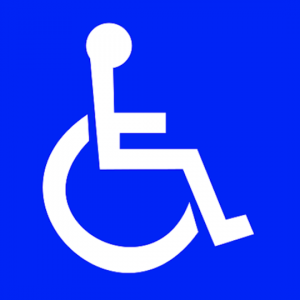By Robin Garr
LouisvilleHotBytes.com
Think about accessibility for disabled people in restaurants and other businesses, and you’ll probably visualize that familiar blue-and-white stick figure in a wheelchair.
That’s not too surprising. The Americans With Disabilities Act, popularly known as the ADA, passed in 1990, is a civil-rights law that prohibits discrimination against individuals with disabilities in all areas of public life.
That means all people with disabilities have the same rights and opportunities as everyone else, says the ADA National Network: Wheelchair users, folks using walkers or canes, people with sight or hearing impairments, and many less visible disabilities including those on the autism spectrum or dealing with post-traumatic stress disorder, dementia, and much more.

But wheelchair access gets attention because it’s easy to see: A wheelchair ramp, a flat entrance that doesn’t trip anyone, a reserved parking space, and that familiar blue-and-white sign.
Accommodations for those with vision or hearing impairments are more difficult to find, often requiring the individual to resort to their own measures, such as screen-reading apps that can scan text and read it aloud.
And that’s not even considering those invisible disabilities. Plate, a magazine and online voice for independent restaurants, restaurant workers, and professional chefs, took on the topic in its Aug. 20, 2023 cover story:
“For most of your guests,” reporter Maggie Hennessy wrote, “the bustle of going out to eat is a thrill … But for someone with an invisible disability, even the quiet hum of fluorescent lighting can take on the irritation level of a gnat relentlessly buzzing in their ear, and trigger a sensory overload episode.
“If no one on staff is trained to recognize what this looks like or how to help, they may instead perceive a child who is entitled or being difficult, or an adult who’s maybe had too much to drink and is acting out.”
This may seem like an uncommon occurrence, but Plate begs to differ, pointing out that the Centers for Disease Control and Prevention estimates that fully one-quarter of all American adults have some type of disability. And roughly one in six Americans has some sensory needs related to such conditions as autism, post-traumatic stress disorder, strokes, and dementia.
How can restaurants improve accessibility?
How can restaurants, and people who dine out, bridge these less visible accessibility gaps?
If you’re going out for a meal with a friend or relative who’s dealing with dementia, the Rev. Georgine Buckwalter – a longtime Episcopal priest and chaplain – offers practical advice from her time on the board of the Kentuckiana Alzheimers Association:
“Carry a little card the size of a business card that says something like ‘The person I’m with has Alzheimer’s. Please direct your questions to them directly. Please overlook any behavior that you think might not be appropriate.’ Palm it, hand it to the server discreetly. It’s not something that the loved one with you needs to know you’ve done. An outing can be so shaming and humiliating for a person with dementia. This can make it much more pleasant.”
A friend who had a stroke a few years ago told me that he has only half of each eye’s field of vision left, making him “exponentially more clumsy.” But, he says, he has learned to take charge of the situation: “If I am sitting at the bar of someplace crowded I usually just tell the person to my right that I am blind and if I get in their space, to just tell me. Most people are decent about it.”
Another friend who has neurodivergent children said there’s a simple, but sadly rare, solution for his youngsters: “Restaurants without menus with photos are impossible for my children. Most fast food corporations provide them for nonverbal communication, but they’re rarely found in the wild. … The amount of money I’ve spent over the years on uneaten food is staggering.”
Betsy Jones, a local commercialization and marketing strategist who has spent nine years collecting evidence-based and fact-based information on how to work with older people and others affected by dementia, PTSD, stroke, and more, offered lots of good ideas and useful advice to write a book about it. Here are a few quick tips for restaurateurs based on her advice:
Hearing
Turn down the volume. Avoid music that has strong percussion or major changes in volume. Design with soft surfaces to absorb sound. And seat people with hearing difficulties in a booth if possible, and away from kitchens and other high traffic areas. Train staff to turn toward the person with hearing loss, and offer a printout of food and drink specials.
Autism (neurodivergence)
Turn music to low, or turn it off while the guest is with you. If a guest wears headphones to filter out sound, do not object.Teach staff to pleasantly bear with children’s activities such as hand flapping, spinning, rocking and finger-flicking. These are not deliberate misbehaviors but efforts to self-regulate sensory input. Staff also should be equipped to offer grace in response to potentially awkward or blunt questions from some.
PTSD
If this condition is revealed—which often it is not—staff should ask if the patron has a seating preference. You want your customer to feel safe. Lighting should be at a level where people can be seen easily. Spacing between tables is critical so the individual can be in control of touch.
Finally, Jones said, it’s important that staff treat a person who has any of these conditions with respect. “Don’t use lilting speech or infantilizing language. Don’t assume that a person needs help – ask first. Don’t speak to their companions rather than the guest herself. Don’t assume that the guest is not intelligent. Staff should handle accommodations quietly, with grace and discretion, never calling attention to a guest’s impairment.”
In short, be thoughtful, and treat people the way you would want to be treated yourself, or that you’d want an older parent or friend to be treated. That’s a good rule for everyone, everywhere.




